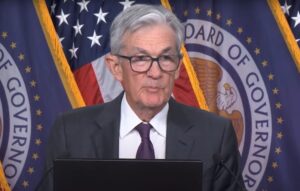At a recent press conference, Federal Reserve Chair Jerome Powell claimed that the Fed’s flexible average inflation targeting (FAIT) framework did not contribute to the post-pandemic inflation surge.
There was nothing moderate about the overshoot. It was — it was an exogenous event. It was the pandemic and it happened and, you know, our framework permitted us to act quite vigorously. And we did once we decided that that’s what we should do. The framework had really nothing to do with the decision to — we looked at the inflation as — as transitory and — right up to the point where the data turned against that. — and when the data turned against that in late ‘21, we changed our — our view and we raised rates a lot. And here we are at 4.1 percent unemployment and inflation way down. But the framework was — was more — was more irrelevant than anything else that — the that part of it — that part of it was irrelevant. The rest of the framework worked just fine as — as we used it — as it supported what we did to bring inflation down.
The temporary rise in inflation and permanent rise in the price level was, according to Powell, beyond the Fed’s control. The Fed’s framework did not inhibit the Fed’s response. To the contrary, Powell said, the framework supported the Fed’s efforts to rein in inflation.
There’s no subtle way to put this: Powell’s account of what happened is incorrect.
Let’s start with the rise in prices. While the price level initially declined below the Fed’s two-percent target when the pandemic hit, it quickly recovered. By March 2021, the overall level of prices had returned to the two-percent growth path. It then rose rapidly until the Fed aggressively tightened monetary policy midway through 2022.
In his recent remarks, Powell describes the rise in prices as “exogenous,” suggesting that it had nothing to do with monetary policy. It is unclear what he means here, but one interpretation is that he is blaming inflation on pandemic-driven supply constraints.
There are several problems with this view. For one, the timing does not make any sense. The worst of the pandemic-induced supply constraints occurred in 2020. The economy had largely recovered from these constraints by the time inflation picked up in late 2021.
Moreover, a temporary reduction in real output, on its own, would not result in a permanent rise in the price level. Absent an increase in nominal spending, the price level would have fallen as real output recovered. That, of course, is not what happened. Real GDP has basically returned to trend, yet the price level remains substantially higher than it would have been had the Fed hit its two-percent inflation target over the past few years.
So what caused the rise in prices?
The short answer is that the Fed’s response to the pandemic resulted in a surge in nominal spending. Mistaking this positive aggregate demand shock for a negative aggregate supply shock, the Fed initially delayed its response. As Powell admits, it is only after “the data turned against that” view that the Fed changed course.
But even that is too charitable. The Fed did eventually change course, but it did not do so right after the data turned against the transitory supply-side story in the back half of 2021, as Powell suggests.
By the time the Fed released its projections in December 2021, Fed officials had access to inflation data through October, which showed inflation had averaged 5.8 percent year-to-date. But the December median inflation projection for 2021 was just 5.3 percent. For that forecast to be accurate, inflation would have needed to average just 2.7 percent in November and December — a sharp decline from the preceding trend. Moreover, Fed officials made no changes to monetary policy at the December meeting, nor did the December median federal funds rate projection for 2021 shift from prior meetings.
In short, it seems as though they expected inflation to fall in the final months of 2021 without any policy tightening — suggesting they still attributed inflation to transitory, pandemic-related supply constraints, despite Powell retiring the term at the end of November.
Fed officials did not act swiftly and decisively once they realized the problem in late 2021, as Powell claims. They did not even begin to raise the federal funds rate target until March 2022 — at least five months after the data revealed a demand-side problem and three months after Fed officials acknowledged that problem. Even then, the Fed officials proceeded slowly, despite inflation surging past their projections during the early months of 2022. Indeed, the real federal funds rate would remain negative until June 2022! It was not until July 2022 that Fed officials finally got serious about getting inflation under control. They raised the federal funds rate target by 75 basis points, and then followed up with several substantial rate hikes throughout the remainder of 2022 and early 2023.
The Fed’s slow response to the surge in aggregate demand pushed the price level well above its pre-pandemic growth path.
Where does the Fed’s FAIT framework come into play? Under FAIT, the Fed targets inflation asymmetrically: it only makes up for inflation undershoots. It does not make up for periods when inflation averages more than 2 percent. Consequently, the price level will not return to its pre-pandemic growth path. That is not an accident. It is the direct result of the Fed’s FAIT framework.
Contrary to Powell’s claims, FAIT is far from irrelevant. It explains why the price level, having grown faster than the Fed had hoped, will now remain permanently elevated despite the Fed’s aggressive rate hikes. Perhaps that’s what Fed officials wanted. Perhaps they would not have done anything differently had they not been constrained by FAIT. If that’s the case, they should say that. The fact is, given the Fed’s adherence to its FAIT framework, they were not able to do anything other than permit the price level to remain permanently elevated.
Getting this history right matters. If Fed officials are going to avoid making similar mistakes in the future, they must take responsibility for their role in driving prices permanently higher. As Fed officials review their framework this year, they should keep the following in mind: either FAIT enabled the price level to rise permanently higher beginning in 2021 or failed to prevent it from rising permanently higher. Either way, it needs to go.












